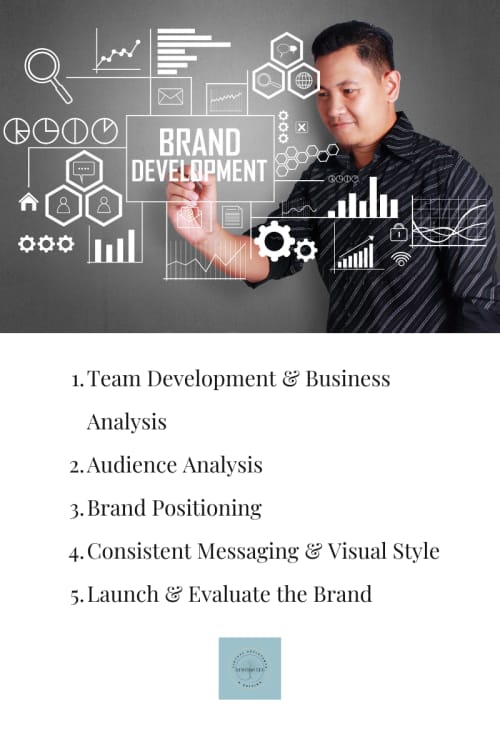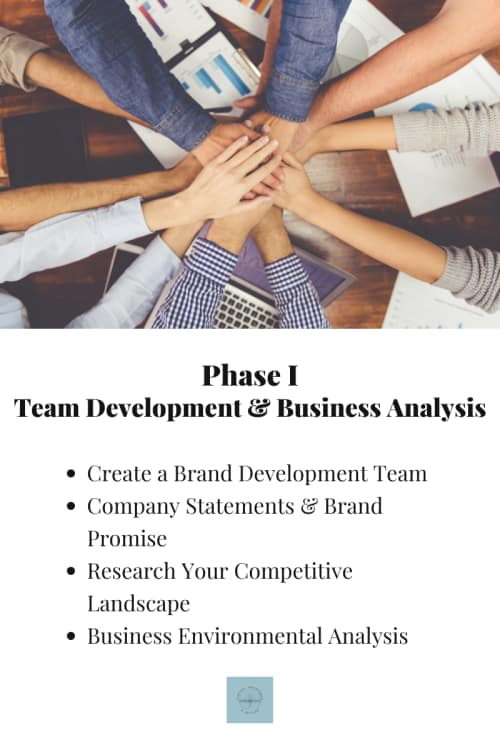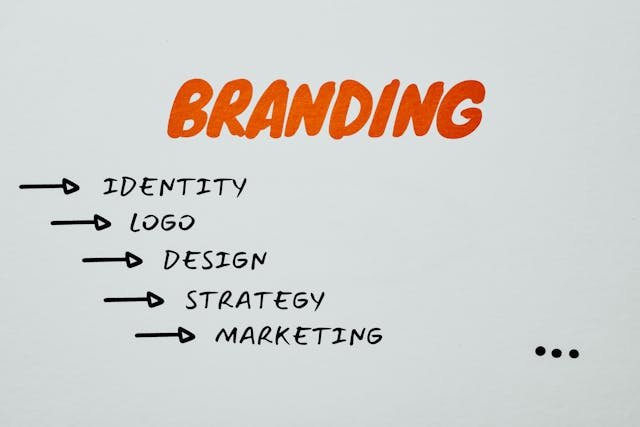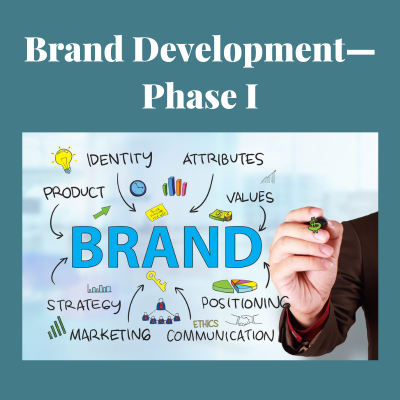Overview of Brand Development
By: Colleen Atwood - Virtual Assistant & Editor
"A brand for a company is like a reputation for a person. You earn reputation by trying to do hard things well."
Jeff Bezos- Businessman
A company brand enables potential clients to find, recognize, and automatically associate products or services with a firm’s name. Further, branding allows an organization to differentiate itself from others, explaining why a business’s offerings are more compelling than the competition. But what do companies just starting—or who want to update the current branding—need to do, and what is the process they should follow?
Over the next five months, Atwood LLC will answer these questions. Today, we give an overview of brand development and will follow up once a month with more detailed blogs for each phase.
Our areas of concentration include:
- Team Development & Business Analysis
- Audience Analysis
- Brand Positioning
- Consistent Messaging & Visual Style
- Launch & Evaluate the Brand
However, before we begin our journey, we must first understand brand development, how it differs from branding, and why companies should use a brand strategy framework.
What is Brand Development?
Small businesses and authors must ensure their clients and readers know who they are, what they stand for, why they exist, and how to recognize them in a busy marketing industry. Firms and authors just starting should follow a step-by-step process known as brand development to create, refine, manage, and monitor (or assess) their communications and distinctive marketing assets.
A brand is the identity and story of a company to help make it stand out from competitors in the marketplace. Often, companies improve their current branding assets based on customer feedback, cultural changes, and shifting business visions. Businesses looking to make these changes can follow the same process as those companies just starting.
When engaged with brand development, companies narrow down such information as the brand goals, its purpose, the target audience, what their competitors are doing, how it wants to position itself, what makes their company unique, and design a brand identity they will use with every communication (from internal emails to messages for its ideal consumers).
However, make sure to understand the difference between brand development and branding.
Difference Between Brand Development & Branding
Companies beginning the brand development process might presume that the logo they create is the only thing they need to make an impression on their target audience. This presumption is not valid. Companies must first research and design a unique brand identity that explains who they are and why they exist, then use the visual representations they create to target their specific market with key messages.
Brand Development
Brand development is a comprehensive and strategic creation process that requires deep thought, extensive research, collaboration with others, and a profound understanding of where a company sees itself in the future. The firm follows a specific process (or approach) that enables the company to learn about itself, understand what makes its products and services unique, and how to support its target audience better than those who sell comparable products and services.
Brand development requires companies to work through phases (or segments) with specific purposes, the order of which allows a business to build on researched and already designed information systematically.
Specifically, brand development aims to learn what makes the company unique from its competition and will resonate with its target audience (a concept known as brand distinction). Companies search for three to five unique selling points (USP) that another company cannot claim as its own. Businesses can use USPs to create an exceptional brand positioning statement that succinctly captures what the brand stands for.
Branding
On the other hand, branding is the strategic use of marketing assets and brand communications for every interaction with the target audience. Marketing assets are the visual representation of what a brand stands for and the story it tells, using properties such as the logo, color palette, and other elements used liberally on each platform. When a company follows a specific tactic (or tactics) to reach its preferred audience and builds its trust over time, it engages in marketing, which, in turn, helps to drive sales for the organization.
Now, we focus on applying a brand strategy framework to the brand development process.
Phases of Brand Development
Due to the complexity of brand development, Atwood LLC plans to break down the entire process into five phases (or stages) a company can use to create its branding process. Within each phase, we include the steps of the brand strategy framework to reflect the information needed accurately. The framework helps an organization clarify the brand’s positioning statement (or purpose, vision, mission, core values, and critical messages) that dictates every form of communication that leaves the firm.
Our goal today is to briefly introduce you to the phases and what you can expect to read in the associated blogs over the next five months. These phases include:

Phase I—Team Development & Business Analysis
The first phase of brand development has four steps:

Create a Brand Development Team
Within the Digital Transformation blog (as well as prior topics), we know that creating a cross-functional team that includes people from each department (as well as executives and management) can result in improved solutions for the firm. Companies that actively encourage open discussions, free sharing of thoughts, differing points of view, and continual collaboration with employees from beginning to end find those involved are more willing to find pride in their contribution and advocate for the brand.
Company Statements & Brand Promise
The promises companies make to their employees and clients directly result from their vision, mission, and core values. Brands do the same thing, although most of their vision, mission, and core values are more internal than external.
Research Your Competitive Landscape
Your firm is entering a competitive marketplace. As such, your firm needs to know who your top direct and indirect competitors are, get background information on the companies, profile the competition’s target market, use the four P’s (product, price, promotion, and place) to your company’s advantage, and complete a SWOT analysis to learn where opportunities lie.
Business Environment Analysis
Companies should always know what is happening in the real world. New legislation, upheavals in the political landscape, and evolving marketing conditions may force businesses to find workable solutions (or alternative methods of responding to) impending changes. By completing a business environment analysis, companies can learn what micro- and macro-environmental factors could have both short- and long-term effects on how a company does business. Using tools like the PESTLE Analysis will help the firm learn this information.
Phase II—Audience Analysis
The second phase in brand development requires the company to complete a deep dive into its target market and find ways to offer consumers products and services that intrigue them and have them coming back for more. Phase two has four steps as well:

Target Market Analysis
First, decide who your target market will be, and then complete primary and secondary research to learn their pain points, motivations, who the influencers are in the industry, and what tools they already use. Your focus is to predict their needs and create messaging that resonates.
Market Segmentation
Second, decide how you plan to segment the target audience. By doing so, a company can create messaging for specific audiences that target a particular need. Using the analysis from the first step, complete added research on your target’s demographic, geographic, psychographic, and behavioral attributes.
Ideal Customer Profile
The third step is where companies create ideal customer profiles for the different target audiences. By filling in the profile questions, the information you found during the research and segmentation processes helps create ideal customers that will help guide your brand’s messaging across platforms.
Buyer Persona
Fourth, once the companies have created their ideal customer profiles, they should make a buyer persona for each profile based on what you can expect during the purchasing process.
Phase III—Brand Positioning
The third phase requires the company to create its brand positioning statement and tagline. To begin this process, companies will implement the brand strategy framework. The first four steps of the framework include:

Create Your Brand Strategy Framework (Part I)
The firm’s brand strategy outlines the goals and aims of the company, which helps direct the business in all future endeavors. The first three steps in the brand strategy require the company to use the information researched, clarified, and adopted by the development team to fill in the missing information and have a complete final document.
Step I—Develop Internal Brand
The information in Phase I—Team Development & Business Analysis supplies the internal brand information the company should include for Step 1. This information includes:
- Brand Vision
- Brand Mission
- Brand Core Values
- Brand Promise
Step II—Define Your Target Audience
The information found in Phase II—Audience Analysis supplies the information in Step 2. This information includes:
- Market Segmentation
- Ideal Customer Profiles
- Buyer Personas
Step III—Map the Competitive Landscape
The information found in Phase 1 supplies the required details for Step 3, including:
- The research you found on your competitors.
- Business environmental analysis results.
Step IV—Create Your Brand Positioning Statement & Tagline
Using the answers above, you should know what makes your company unique, which products or services you should offer (that others are not), and why your target consumers should choose your business over the competition.
With this information, you should now draft your brand positioning statement (a 3–5 sentence paragraph) that succinctly captures the essence of your brand. Once written, you can draft your tagline (a simple message summarizing your brand positioning statement clearly).
Phase IV—Consistent Messaging & Visual Style
The fourth phase requires the company to continue working on the brand strategy framework and fill in the information on:

Continue Working on the Brand Strategy Framework (Part II)
The fifth through ninth steps of the brand strategy framework fill in more details about how the company will project itself to its target market and design the physical and digital marketing assets it plans to use with every communication.
Step V—Shape Your Brand Personality, Voice & Tone
Just as one human being differs from every other human, brands should also reflect this distinction. Documenting a company’s personality, voice, and tone (or how it says something to the target market) presents a specific image (or impression) of the organization. The brand storytelling aspect of marketing thus becomes easier over time—there is no deviation with messages and fewer miscommunications when everyone adopts the same personality, voice, and tone.
Step VI—Develop a Messaging Strategy
The brand’s messaging strategy becomes especially important as you want to ensure you approach your target markets accordingly. Using the brand promise and positioning statements as your guide, decide the underlying (or critical) message you want your target markets to know. Then, tailor key messages you want for each target market that respond explicitly to their wants and needs. Make sure to document these messages for future reference. (NOTE: You may wish to create a brand messaging strategy to help focus your message.)
Step VII—Create Your Brand Story
Each business has a unique beginning; customers will want to know that story. They like to see how you started, what you plan to do, how you believe you can help them solve their problems, and then decide if they can identify with your brand emotionally (even if they do not consciously admit to doing so). Narrating this information is a form of brand storytelling and often sets the stage for how your firm will interact with potential clients.
Step VIII—Design Your Brand Identity
The brand identity is a visual representation (or elements) of who the company is, its purpose, and what it stands for, something businesses use in every marketing message. The resources your business creates include the company logo, a style guide (written and digital), the brand’s color palette, and even the images and typography the firm will use.
Step IX—Create Your Marketing Toolkit
A marketing toolkit is a collection of shared information on the company’s key product and service offerings, its elevator pitch, a sales sheet that details core offerings, and any other pertinent information your firm wishes to share with the public. Companies may also want to create an internal marketing toolkit that stores templates for various marketing projects.
Phase V—Launch & Evaluate the Brand
The final phase and step of brand development and the framework includes launching the brand, analyzing how it is doing, optimizing the process, and continuously evolving with the marketplace to remain competitive and relevant in a changing environment.

Finish the Brand Strategy Framework (Part III)
Whether designing your first brand strategy or updating your current information, the completed framework (Steps I–XI) is only the first phase of a much more significant concept known as brand management. The information here supplies the backbone for every marketing communication your firm sends. As the marketplace evolves, so should the brand. This transition signals the completion of one and the beginning of another concept that works for businesses of all sizes and within every industry.
Step XI—Launch, Analyze, Optimize & Evolve Your Brand
The last step of your framework and brand development process has five elements, including (1) designing your brand awareness strategy, (2) launching your brand, (3) analyzing its progress, (4) optimizing, and (5) continuously evolving your brand, as necessary.
- Brand Awareness Strategy. Now that you have all the tools you need to share with your target market, you must find ways to share that information. To do so, you should implement a blend of marketing strategies focusing on specific platforms (website, social media, email, and others) to help you reach your audience.
- Launch your brand. If you are a new company (or have updated your brand), make your website go live. Share the information on social media about your new company, blending informational, educational, promotional, inspirational, and persuasive messaging to pique the interest of your audience.
- Analyze its progress. Using KPIs and metrics for each strategy created (including your brand development plan), track how well things are going. Create a spreadsheet or use a program to keep track of the KPIs and metrics and become familiar with how to read your analytical data.
- Optimize the process and plan. Over time, your firm will begin to recognize where there may be issues with specific strategies, platforms, processes, or other relevant technologies. Change the strategy or update the entire process when this happens.
- Continuously evolve to remain relevant. Companies that decide to improve processes that directly affect how their customers see them will typically implement a business process analysis to help them figure out exactly what they can do to stay relevant and competitive.
What to Expect
The brand development process for companies of all sizes may follow the same brand strategy framework. Still, the process’s results illuminate each company’s uniqueness and how they can carve themselves a place in a busy and changing market.
Atwood LLC will delve into each brand development phase in more detail over the next five months. Here is when you can expect to view these blogs:
- March 26, 2024: Phase I—Team Development & Business Analysis
- May 7, 2024: Phase II—Audience Analysis
- June 4, 2024: Phase III—Brand Positioning
- July 2, 2024: Phase IV—Consistent Messaging & Visual Style
- August 6, 2024: Phase V—Launch & Evaluate the Brand
Until next time.


